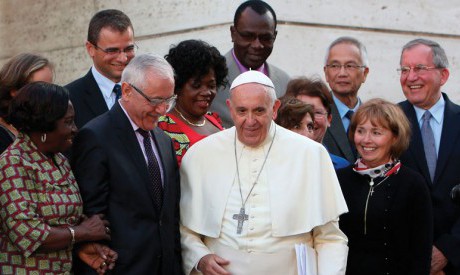When the XIV Ordinary General Assembly of the Synod of Bishops opened with a concelebrated Mass at the Altar of the Confession in St. Peter’s Basilica on October 4, it was already clear that there would be three synods: the real synod, the mainstream media synod, and the blogosphere synod.
The first and third would be daily affairs; the second would be more sporadic. Both participants and observers wondered what effect the second and third would have on the first.
As things turned out, the short answer to that initial puzzlement was “not much,” except by way of providing occasional amusement and aggravation. As always, the mainstream media kept looking for confirmation of its Rorschach-blot reading of Pope Francis as the long-awaited papal reformer who would adjust Catholic doctrine and practice to the zeitgeist, especially in terms of the sexual revolution.
The blogosphere, dependent on the mainstream media for what it foolishly regarded as accurate information, was divided between those who enthusiastically shared these hopes for a Franciscan revolution of a liberal Protestant sort, and those who were scared to death that the enthusiasts were right about the pope from the end of the earth.
So the media synod and the blogosphere synod followed their own prepackaged scripts, and were not very interesting as a result.
The actual synod, however, was another matter.
Real issues were debated, with real consequences at stake. Some of this was visible atop the froth of the mainstream media and blogosphere commentary. How would the Catholic Church settle the argument, launched by Cardinal Walter Kasper in February 2014, about its long-standing and doctrinally informed discipline of not admitting the divorced and civilly remarried to Holy Communion? And beneath that debate, other and deeper issues loomed.
Perhaps the most fundamental involved the claims of revelation on the pastoral life of the Church. Did the Catholic Church still affirm the Second Vatican Council’s teaching in the Dogmatic Constitution on Divine Revelation, Dei Verbum, on the reality and binding force of divine revelation?
How was revelation to be related to the signs of the times, which the Church was enjoined to read by Vatican II’s Pastoral Constitution on the Church in the Modern World, Gaudium et Spes? And how did all of that bear on the relationship between mercy and truth, between pastoral accompaniment and pastoral challenge, between one’s condition of life and one’s ability to receive the grace of the sacraments? Continue reading
Sources
- First Things, from an article by George Weigel, who is Distinguished Senior Fellow of Washington’s Ethics and Public Policy Center.
- Image: OSV Weekly
